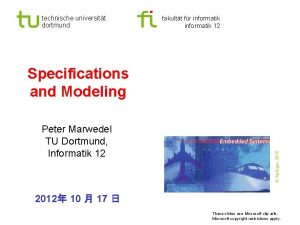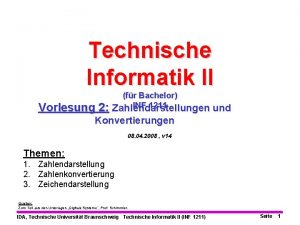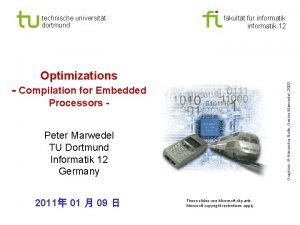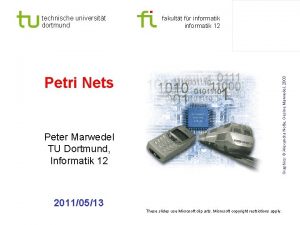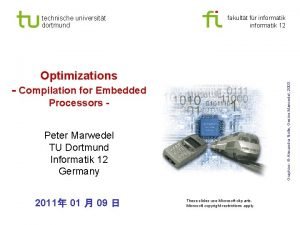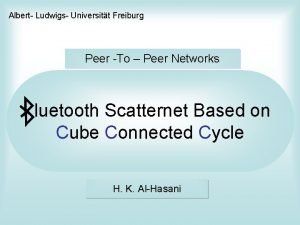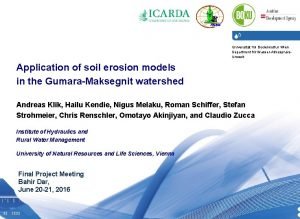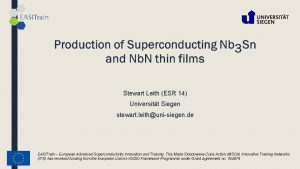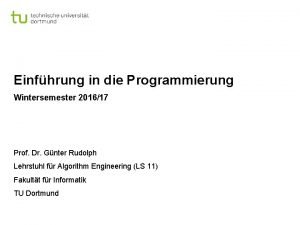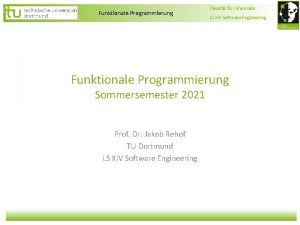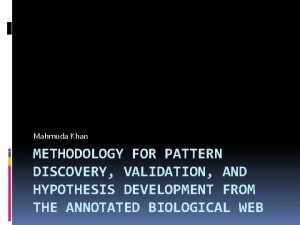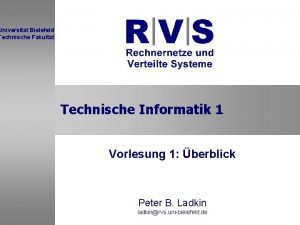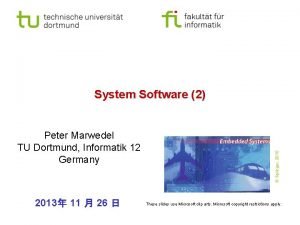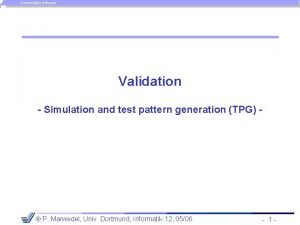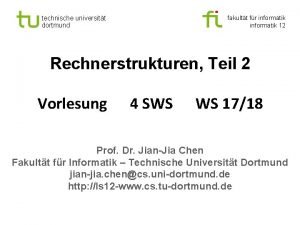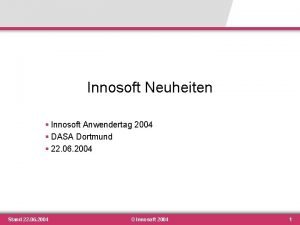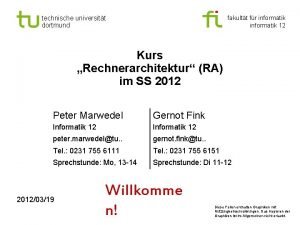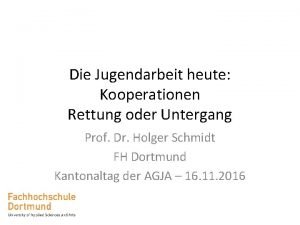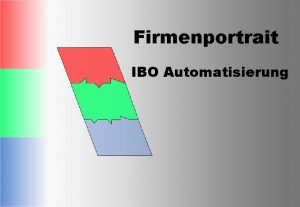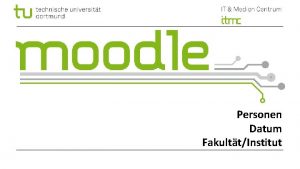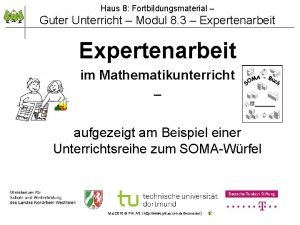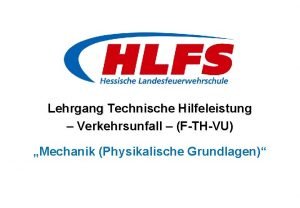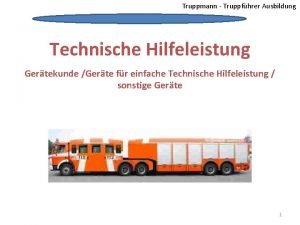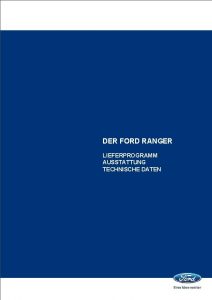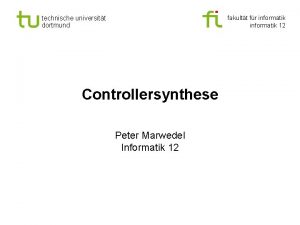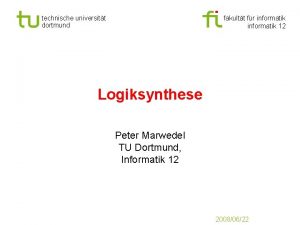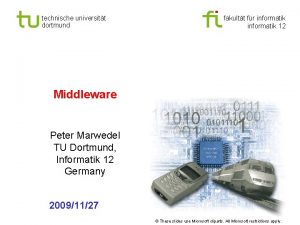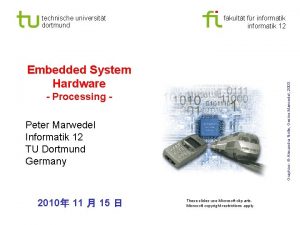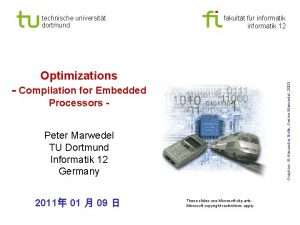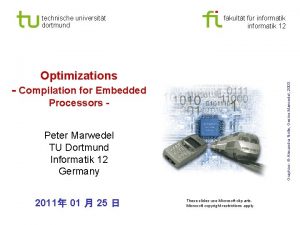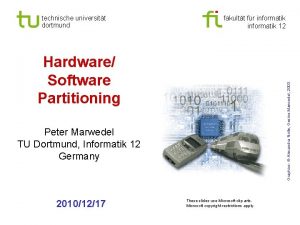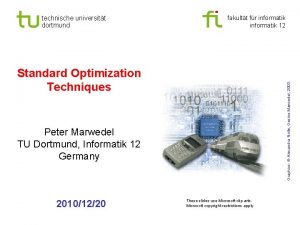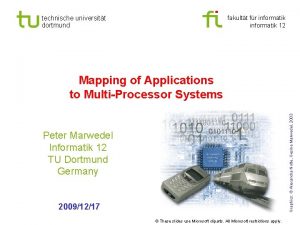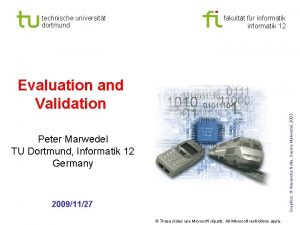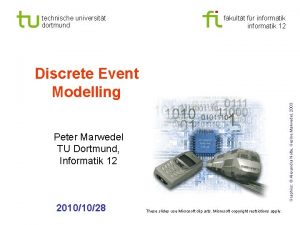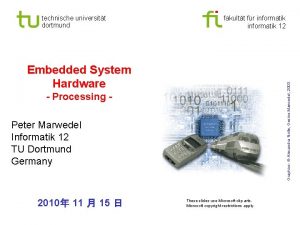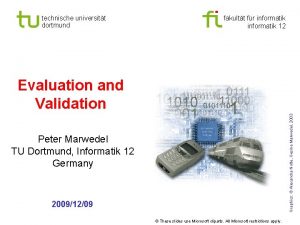technische universitt dortmund fakultt fr informatik 12 Graphics











![Reduction in energy and average run-time Cycles [x 100] Energy [µJ] Feasib le with Reduction in energy and average run-time Cycles [x 100] Energy [µJ] Feasib le with](https://slidetodoc.com/presentation_image_h2/145ca6d3ce9fec5134094744c0644273/image-12.jpg)



















![Memory hierarchy layer assignment (MHLA) - Copy candidates int A[250] for (i=0; i<10; i++) Memory hierarchy layer assignment (MHLA) - Copy candidates int A[250] for (i=0; i<10; i++)](https://slidetodoc.com/presentation_image_h2/145ca6d3ce9fec5134094744c0644273/image-32.jpg)











- Slides: 43

technische universität dortmund fakultät für informatik 12 Graphics: © Alexandra Nolte, Gesine Marwedel, 2003 Optimizations - Compilation for Embedded Processors Peter Marwedel TU Dortmund Informatik 12 Germany 2011年 01 月 12 日 These slides use Microsoft clip arts. Microsoft copyright restrictions apply.

Application Knowledge Structure of this course 2: Specification Design repository 3: ES-hardware 6: Application mapping 4: system software (RTOS, middleware, …) Design 8: Test 7: Optimization 5: Evaluation & validation & (energy, cost, performance, …) Numbers denote sequence of chapters technische universität dortmund fakultät für informatik p. marwedel, informatik 12, 2011 - 2 -

Compilers for embedded systems: Why are compilers an issue? § Many reports about low efficiency of standard compilers - Special features of embedded processors have to be exploited. - High levels of optimization more important than compilation speed. - Compilers can help to reduce the energy consumption. - Compilers could help to meet real-time constraints. § Less legacy problems than for PCs. - There is a large variety of instruction sets. - Design space exploration for optimized processors makes sense technische universität dortmund fakultät für informatik p. marwedel, informatik 12, 2011 - 3 -

Energy-aware compilation (1): Optimization for lowenergy the same as for high performance? No ! • High-performance if available memory bandwidth fully used; low-energy consumption if memories are at stand-by mode • Reduced energy if more values are kept in registers LDR r 3, [r 2, #0] ADD r 3, r 0, r 3 MOV r 0, #28 LDR r 0, [r 2, r 0] ADD r 0, r 3, r 0 ADD r 2, #4 ADD r 1, #1 CMP r 1, #100 BLT LL 3 2096 int a[1000]; c = a; for (i = 1; i < 100; i++) { b += *c; b += *(c+7); c += 1; } cycles 19. 92 µJ technische universität dortmund fakultät für informatik 2231 cycles 16. 47 µJ p. marwedel, informatik 12, 2011 ADD r 3, r 0, r 2 MOV r 0, #28 MOV r 2, r 12 MOV r 12, r 11 MOV r 11, rr 10 MOV r 0, r 9 MOV r 9, r 8 MOV r 8, r 1 LDR r 1, [r 4, r 0] ADD r 0, r 3, r 1 ADD r 4, #4 ADD r 5, #1 CMP r 5, #100 BLT LL 3 - 4 -

Energy-aware compilation (2) § Operator strength reduction: e. g. replace * by + and << § Minimize the bitwidth of loads and stores § Standard compiler optimizations with energy as a cost function R 2: =a[0]; for i: = 1 to 10 do begin R 1: = a[i]; C: = 2 * R 1 + R 2; R 2 : = R 1; end; E. g. : Register pipelining: for i: = 0 to 10 do C: = 2 * a[i] + a[i-1]; Exploitation of the memory hierarchy technische universität dortmund fakultät für informatik p. marwedel, informatik 12, 2011 - 5 -

Energy-aware compilation (3) § Energy-aware scheduling: the order of the instructions can be changes as long as the meaning does not change. Goal: reduction of the number of signal transitions Popular (can be done as a post-pass optimization with no change to the compiler). § Energy-aware instruction selection: among valid instruction sequences, select those minimizing energy consumption § Exploitation of the memory hierarchy: huge difference between the energy consumption of small and large memories technische universität dortmund fakultät für informatik p. marwedel, informatik 12, 2011 - 6 -

3 key problems for future memory systems 1. (Average) Speed 2. Energy/Power 3. Predictability/WCET Energy Access times technische universität dortmund fakultät für informatik p. marwedel, informatik 12, 2011 - 7 -

Hierarchical memories using scratch pad memories (SPM) Hierarchy Example main SPM Address space processor 0 ARM 7 TDMI cores, well-known for low power consumption scratch pad memory no tag memory FFF. . technische universität dortmund fakultät für informatik p. marwedel, informatik 12, 2011 - 8 -

Very limited support in ARMcc-based tool flows 1. Use pragma in C-source to allocate to specific section: For example: #pragma arm section rwdata = "foo", rodata = "bar" int x 2 = 5; // in foo (data part of region) int const z 2[3] = {1, 2, 3}; // in bar 2. Input scatter loading file to linker for allocating section to specific address range http: //www. arm. com/documentation/ Software_Development_Tools/index. html technische universität dortmund fakultät für informatik p. marwedel, informatik 12, 2011 - 9 -

Migration of data & instructions, global optimization model (TU Dortmund) For i. { } Example: for j. . { } while. . . Repeat main memory call. . . Array. . . Scratch pad memory, capacity SSP Processor technische universität dortmund ? Which memory object (array, loop, etc. ) to be stored in SPM? Non-overlaying (“Static”) allocation: Gain gk and size sk for each object k. Maximise gain G = gk, respecting size of SPM SSP sk. Solution: knapsack algorithm. Array Overlaying (“dynamic”) allocation: Int. . . Moving objects back and forth fakultät für informatik p. marwedel, informatik 12, 2011 - 10 -

ILP representation - migrating functions and variables. Symbols: S(vark ) = size of variable k n(vark) = number of accesses to variable k e(vark ) = energy saved per variable access, if vark is migrated E(vark ) = energy saved if variable vark is migrated (= e(vark) n(vark)) x(vark ) = decision variable, =1 if variable k is migrated to SPM, =0 otherwise K = set of variables; similar for functions I Integer programming formulation: Maximize k K x(vark) E(vark ) + i I x(Fi ) E(Fi ) Subject to the constraint k K S(vark) x(vark ) + i I S(Fi ) x(Fi) SSP technische universität dortmund fakultät für informatik p. marwedel, informatik 12, 2011 -
![Reduction in energy and average runtime Cycles x 100 Energy µJ Feasib le with Reduction in energy and average run-time Cycles [x 100] Energy [µJ] Feasib le with](https://slidetodoc.com/presentation_image_h2/145ca6d3ce9fec5134094744c0644273/image-12.jpg)
Reduction in energy and average run-time Cycles [x 100] Energy [µJ] Feasib le with standa rd com piler & postp a optimiz ss ation Multi_sort (mix of sort algorithms) Measured processor / external memory energy + CACTI values for SPM (combined model) technische universität dortmund fakultät für informatik Numbers will change with technology, algorithms remain unchanged. p. marwedel, informatik 12, 2011 - 12 -

Using these ideas with an gcc-based tool flow Source is split into 2 different files by specially developed memory optimizer tool *. main mem. src application source. c . txt . c Memory optimizer (Incl. ICDC*) ARM-GCC Compiler spm src. . c ARM-GCC Compiler profile Info. . ld linker script * Built with tool design suite ICD-C available from ICD (see www. icd. de/es) technische universität dortmund fakultät für informatik . exe p. marwedel, informatik 12, 2011 - 13 -

Allocation of basic blocks Fine-grained granularity smoothens dependency on the size of the scratch pad. Main memory BB 1 Jump 2 Requires additional jump instructions to return to "main" memory. technische universität dortmund Jump 1 Jump 3 Statically 2 jumps, but only one is taken For consecutive basic blocks BB 2 Jump 4 fakultät für informatik p. marwedel, informatik 12, 2011 - 14 -

Allocation of basic blocks, sets of adjacent basic blocks and the stack Cycles [x 100] Energy [µJ] Requir es gen eration additio of nal jum p s (specia l comp iler) technische universität dortmund fakultät für informatik p. marwedel, informatik 12, 2011 - 15 -

Savings for memory system energy alone Combined model for memories technische universität dortmund fakultät für informatik p. marwedel, informatik 12, 2011 - 16 -

Scratch-pad/tightly coupled memory based predictability Pre run-time scheduling is often the only practical means of providing predictability in a complex system. [Xu, Parnas] Time-triggered, statically scheduled operating systems Let‘s do the same for the memory system Are SPMs really more timing predictable? Analysis using the ai. T timing analyzer C program SPM size technische universität dortmund memory-aware compiler ARMulator Actual performance executable ai. T Worst case execution time fakultät für informatik p. marwedel, informatik 12, 2011 - 17 -

Architectures considered ARM 7 TDMI with 3 different memory architectures: 1. Main memory LDR-cycles: (CPU, IF, DF)=(3, 2, 2) STR-cycles: (2, 2, 2) * = (1, 2, 0) 2. Main memory + unified cache LDR-cycles: (CPU, IF, DF)=(3, 12, 6) STR-cycles: (2, 12, 3) * = (1, 12, 0) 3. Main memory + scratch pad LDR-cycles: (CPU, IF, DF)=(3, 0, 2) STR-cycles: (2, 0, 0) * = (1, 0, 0) technische universität dortmund fakultät für informatik p. marwedel, informatik 12, 2011 - 18 -

Results for G. 721 Using Scratchpad: Using Unified Cache: References: § Wehmeyer, Marwedel: Influence of Onchip Scratchpad Memories on WCET: 4 th Intl Workshop on worst-case execution time (WCET) analysis, Catania, Sicily, Italy, June 29, 2004 § Second paper on SP/Cache and WCET at DATE, March 2005 technische universität dortmund fakultät für informatik p. marwedel, informatik 12, 2011 - 19 -

Multiple scratch pads 0 Small is beautiful: scratch pad 1, 2 k entries One small SPM is beautiful ( ). technische universität dortmund scratch pad 2, 16 k entries addresses May be, several smaller SPMs are even more beautiful? scratch pad 0, 256 entries fakultät für informatik background memory p. marwedel, informatik 12, 2011 - 20 -

Optimization for multiple scratch pads Minimize With ej: energy per access to memory j, and xj, i= 1 if object i is mapped to memory j, =0 otherwise, and ni: number of accesses to memory object i, subject to the constraints: With Si: size of memory object i, SSPj: size of memory j. technische universität dortmund fakultät für informatik p. marwedel, informatik 12, 2011 - 21 -

Considered partitions Example of considered memory partitions for a total capacity of 4096 bytes # of partitions number of partitions of size: 4 k 2 k 1 k 512 256 128 64 7 0 1 1 1 2 6 0 1 1 2 0 5 0 1 1 1 2 0 0 4 0 1 1 2 0 0 0 3 0 1 2 0 0 0 1 1 0 0 0 technische universität dortmund fakultät für informatik p. marwedel, informatik 12, 2011 - 22 -

Results for parts of GSM coder/ decoder „Working set“ A key advantage of partitioned scratchpads for multiple applications is their ability to adapt to the size of the current working set. technische universität dortmund fakultät für informatik p. marwedel, informatik 12, 2011 - 23 -

Dynamic replacement within scratch pad CPU SPM Memory § Effectively results in a kind of compiler-controlled segmentation/ paging for SPM § Address assignment within SPM required (paging or segmentationlike) Reference: Verma, Marwedel: Dynamic Overlay of Scratchpad Memory for Energy Minimization, ISSS 2004 technische universität dortmund fakultät für informatik p. marwedel, informatik 12, 2011 - 24 -

Dynamic replacement of data within scratch pad: based on liveness analysis B 1 DEF A B 2 B 9 MOD A B 3 USE T 3 B 5 T 3 B 4 B 6 MO = {A, T 1, T 2, T 3, T 4} SP Size = |A| = |T 1| …= |T 4| SPILL_STORE(A); SPILL_LOAD(T 3); Solution: A SP & T 3 SP USE T 3 USE A B 10 B 7 SPILL_LOAD(A); B 8 technische universität dortmund USE A fakultät für informatik p. marwedel, informatik 12, 2011 - 25 -

Dynamic replacement within SPM Edge detection relative to static allocation technische universität dortmund fakultät für informatik p. marwedel, informatik 12, 2011 - 26 -

Hardware-support for block-copying Memory DMA Scratch-pad Processor The DMA unit was modeled in VHDL, simulated, synthesized. Unit only makes up 4% of the processor chip. The unit can be put to sleep when it is unused. Code size reductions of up to 23% for a 256 byte SPM were determined using the DMA unit instead of the overlaying allocation that uses processor instructions for copying. [Lars Wehmeyer, Peter Marwedel: Fast, Efficient and Predictable Memory Accesses, Springer, 2006] technische universität dortmund fakultät für informatik p. marwedel, informatik 12, 2011 - 27 -

References to large arrays (1) - Regular accesses for (i=0; i<n; i++) for (j=0; j<n; j++) for (k=0; k<n; k++) U[i][j]=U[i][j] + V[i][k] * W[k][j] Tiling for (it=0; it<n; it=it+Sb) {read_tile V[it: it+Sb-1, 1: n] for (jt=0; jt<n; jt=jt+Sb) {read_tile U[it: it+Sb-1, jt: jt+Sb-1]; read_tile W[1: n, jt: jt+Sb-1]; U[it: it+Sb-1, jt: jt+Sb-1]=U[it: it+Sb-1, jt: jt+Sb-1] + V[it: it+Sb-1, 1: n] * W [1: n, jt: jt+Sb-1]; write_tile U[it: it+Sb-1, jt: jt+Sb-1] [M. Kandemir, J. Ramanujam, M. J. Irwin, N. Vijaykrishnan, I. Kadayif, A. Parikh: Dynamic Management of Scratch-Pad }} Memory Space, DAC, 2001, pp. 690 -695] technische universität dortmund fakultät für informatik p. marwedel, informatik 12, 2011 - 28 -

References to large arrays - Irregular accesses for each loop nest L in program P { apply loop tiling to L based on the access patterns of regular array references; for each assignment to index array X update the block minimum and maximum values of X; compute the set of array elements that are irregularly referenced in the current inter-tile iteration; compare the memory access costs for using and not using SPM; if (using SPM is beneficial) execute the intra-tile loop iterations by using the SPM else execute the intra-tile loop iterations by not using the SPM [G. Chen, O. Ozturk, M. Kandemir, M. Karakoy: Dynamic } Scratch-Pad Memory Management for Irregular Array Access Patterns, DATE, 2006] technische universität dortmund fakultät für informatik p. marwedel, informatik 12, 2011 - 29 -

Results for irregular approach Cache Kandemir@DATE 06 Kandemir@DAC 01 technische universität dortmund fakultät für informatik p. marwedel, informatik 12, 2011 - 30 -

Hierarchical memories: Memory hierarchy layer assignment (MHLA) (IMEC) n layers with "partitions" consisting of modules Partition n. 1 … Partition 2. 1 Partition 2. 2 Partition 1. 1 SPM-module 1. 1. 1 Partition 1. 2 SPM-module 1. 1. 2 Cachemodule 1. 2. 2 [E. Brockmeyer et al. : Layer Assignment Techniques for Low Energy in Multi-Layered Memory Organisations, Design, Automation and Test in Europe (DATE), 2003. ] Processor technische universität dortmund Cachemodule 1. 2. 1 fakultät für informatik p. marwedel, informatik 12, 2011 - 31 -
![Memory hierarchy layer assignment MHLA Copy candidates int A250 for i0 i10 i Memory hierarchy layer assignment (MHLA) - Copy candidates int A[250] for (i=0; i<10; i++)](https://slidetodoc.com/presentation_image_h2/145ca6d3ce9fec5134094744c0644273/image-32.jpg)
Memory hierarchy layer assignment (MHLA) - Copy candidates int A[250] for (i=0; i<10; i++) for (j=0; j<10; j++) for (k=0; k<10; k++) for (l=0; l<10; l++) f(A[j*10+l]) size=0; reads(A)=10000 int A[250] for (i=0; i<10; i++) for (j=0; j<10; j++) {A"[0. . 9]=A[j*10. . j*10+9]; for (k=0; k<10; k++) for (l=0; l<10; l++) f(A"[l])} size=10; reads(A)=1000 int A[250] for (i=0; i<10; i++) {A'[0. . 99]=A[0. . 99]; for (j=0; j<10; j++) for (k=0; k<10; k++) for (l=0; l<10; l++) f(A'[j*10+l])} size=100; reads(A)=1000 int A[250] A'[0. . 99]=A[0. . 99]; for (i=0; i<10; i++) for (j=0; j<10; j++) for (k=0; k<10; k++) for (l=0; l<10; l++) f(A'[j*10+l]) size=100; reads(A)=100 technische universität dortmund fakultät für informatik p. marwedel, informatik 12, 2011 Copy candidate A', A" in small memory reads(A) 10000 100 10 100 size - 32 -

Memory hierarchy layer assignment (MHLA) - Goal: For each variable: find permanent layer, partition and module & select copy candidates such that energy is minimized. Conflicts between variables [E. Brockmeyer et al. : Layer Assignment Techniques for Low Energy in Multi-Layered Memory Organisations, Design, Automation and Test in Europe (DATE), 2003. ] technische universität dortmund fakultät für informatik p. marwedel, informatik 12, 2011 - 33 -

Memory hierarchy layer assignment (MHLA) - Approach: § start with initial variable allocation § incrementally improve initial solution such that total energy is minimized. Current assignment NOT assigned copy candidates Next assignment Platform NOT assigned copy candidates copy candidate 250 A 100 1250 A’ L 3 L 2 1000 A” 10000 Platform technische universität dortmund 1250 100 350 A’ 1000 L 1 11000 A A” L 0 10000 fakultät für informatik step 1 step 2 11000 p. marwedel, informatik 12, 2011 L 3 L 2 L 1 L 0 More general hardware architecture than the Dortmund approach, but no global optimization. - 34 -

Saving/Restoring Context Switch Saving/Restoring at context switch Saving/Restoring at P 3 context switch P 2 Process P 3 Process P 1 P 2 Scratchpad technische universität dortmund P 1 Saving Context Switch (Saving) § Utilizes SPM as a common region shared all processes § Contents of processes are copied on/off the SPM at context switch § Good for small scratchpads fakultät für informatik p. marwedel, informatik 12, 2011 - 35 -

Non-Saving Context Switch Process P 1 P 3 P 2 P 1 Process P 2 Process P 3 Scratchpad technische universität dortmund Non-Saving Context Switch § Partitions SPM into disjoint regions § Each process is assigned a SPM region § Copies contents during initialization § Good for large scratchpads fakultät für informatik p. marwedel, informatik 12, 2011 - 36 -

Hybrid Context Switch Saving/Restoring at context switch Process P 1 Saving/Restoring at P 3 context switch P 2 Process P 3 Process. P 2 P 3 P 1, P 2, P 3 Scratchpad technische universität dortmund P 1 Hybrid Context Switch (Hybrid) § Disjoint + Shared SPM regions § Good for all scratchpads § Analysis is similar to Non-Saving Approach § Runtime: O(n. M 3) fakultät für informatik p. marwedel, informatik 12, 2011 - 37 -

Multi-process Scratchpad Allocation: Results SPA: Single Process Approach 27% § For small SPMs (64 B-512 B) Saving is better edge detection, § For large SPMs (1 k. B- 4 k. B) Non-Saving is better adpcm, g 721, mpeg § Hybrid is the best for all SPM sizes. § Energy reduction @ 4 k. B SPM is 27% for Hybrid approach technische universität dortmund fakultät für informatik p. marwedel, informatik 12, 2011 - 38 -

Dynamic set of multiple applications Compile-time partitioning of SPM no longer feasible Address space: CPU SPM Introduction of SPM-manager § Runtime decisions, but compile-time supported SPM MEM App. 1 App. 2 ? App. 3 SPM Manager SPM App. 2 App. 1 App. n t [R. Pyka, Ch. Faßbach, M. Verma, H. Falk, P. Marwedel: Operating system integrated energy aware scratchpad allocation strategies for multi-process applications, SCOPES, 2007] technische universität dortmund fakultät für informatik p. marwedel, informatik 12, 2011 - 39 -

Approach overview § § 2 steps: compile-time analysis & runtime decisions No need to know all applications at compile-time Capable of managing runtime allocated memory objects Integrates into an embedded operating system App. 1 App. 2 Compile-time Transformations Standard Compiler (GCC) App. n Profit values / Allocation hints Allocation Manager Operating System Using MPArm simulator from U. Bologna technische universität dortmund fakultät für informatik p. marwedel, informatik 12, 2011 - 40 -

Results § MEDIA+ Energy § Baseline: Main memory only § Best: Static for 16 k 58% § Overall best: Chunk 49% MEDIA+ Cycles § Baseline: Main memory only § Best: Static for 16 k 65% § Overall best: Chunk 61% technische universität dortmund fakultät für informatik p. marwedel, informatik 12, 2011 - 41 -

Comparison of SPMM to Caches for SORT § Baseline: Main memory only § SPMM peak energy reduction by 83% at 4 k Bytes scratchpad § Cache peak: 75% at 2 k 2 -way cache SPM Size Δ 4 -way 1024 74, 81% 2048 65, 35% 4096 64, 39% 8192 65, 64% 16384 63, 73% technische universität dortmund fakultät für informatik § SPMM capable of outperforming caches § OS and libraries are not considered yet Chunk allocation results: p. marwedel, informatik 12, 2011 - 42 -

Summary Impact of memory architecture on execution times & energy consumption § The SPM provides • Runtime efficiency, energy efficiency, timing predictability § Allocation strategies • Static allocation - Partitioning - Timing predictability • Dynamic allocation - Tiling Multiple hierarchy levels Multiple processes Dynamic sets of processes § Savings dramatic, e. g. ~ 95% of the memory energy technische universität dortmund fakultät für informatik p. marwedel, informatik 12, 2011 - 43 -
 Oth regensburg technische informatik
Oth regensburg technische informatik Rechnerstrukturen tu dortmund
Rechnerstrukturen tu dortmund Technische informatik 2 tu bs
Technische informatik 2 tu bs Technische graphics
Technische graphics Technische graphics
Technische graphics Technische graphics
Technische graphics Ccc freiburg
Ccc freiburg Universitt wien
Universitt wien Universitt
Universitt Harvard universitt
Harvard universitt Most of the graphics monitors today operate as
Most of the graphics monitors today operate as Introduction to computer graphics ppt
Introduction to computer graphics ppt Technische lego
Technische lego Valutierend
Valutierend Retina tu dortmund
Retina tu dortmund Funktionale programmierung tu dortmund
Funktionale programmierung tu dortmund Thermico dortmund
Thermico dortmund Ub dortmund
Ub dortmund Dortmund arbeitslosenquote
Dortmund arbeitslosenquote Zubair khan dortmund
Zubair khan dortmund Tu dortmund rechnerstrukturen
Tu dortmund rechnerstrukturen Hazardfehler
Hazardfehler Lsf fh dortmund
Lsf fh dortmund Srp tu dortmund
Srp tu dortmund Dortmund pattern
Dortmund pattern Tu dortmund rechnerstrukturen
Tu dortmund rechnerstrukturen Michael karagounis
Michael karagounis Dr alexandra nolte
Dr alexandra nolte Innosoft einsatzplanung
Innosoft einsatzplanung Rechnerarchitektur tu dortmund
Rechnerarchitektur tu dortmund Boss tu dortmund
Boss tu dortmund Holger schmidt fh dortmund
Holger schmidt fh dortmund E3t tu dortmund
E3t tu dortmund Aufzug im brandfall nicht benutzen rechtsgrundlage
Aufzug im brandfall nicht benutzen rechtsgrundlage Ostrzenski dortmund
Ostrzenski dortmund Ews tu dortmund
Ews tu dortmund Pikas uni dortmund
Pikas uni dortmund Studentensekretariat tu dortmund
Studentensekretariat tu dortmund Functionele indeling
Functionele indeling Einfache technische hilfeleistung
Einfache technische hilfeleistung Omzetsnelheid voorraad berekenen
Omzetsnelheid voorraad berekenen Hebelgesetz schubkarre
Hebelgesetz schubkarre Zweiarmiger hebel
Zweiarmiger hebel Technische daten ford ranger raptor
Technische daten ford ranger raptor

